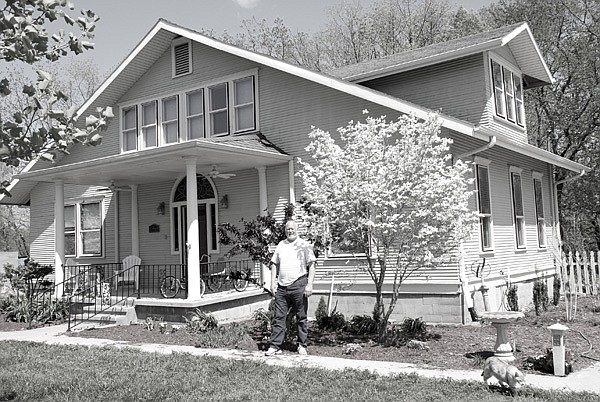Marty and Tom Snead recently contacted me to see if I was interested in writing a story about their historic home just north of the Rogers airport at 10960 N. Old Wire Road. What is special about it? Records indicate it was built about the mid-1880s at the southwest corner of Walnut and Third streets and has been the home of colorful and interesting people such as H.L. Stroud of Stroud’s Department Store; Tom Morgan, a famous Rogers’ turn-of-the-century humorist, writer, and local merchant; and Vera Key, an important civic leader.
Research revealed the Morgan family moved into the old Stroud house in 1890. H.L. Stroud moved to Rogers in 1884, and this may have been his first home. Stroud sold this house and about 1890 built the grand home at the corner of Fourth and Walnut, now Callison Funeral Home.
Who was Tom Morgan? As a young adult, he performed with a comedy company, and a 1915 newspaper article described his act: “He can tell stories in the Arkansas language (dialect) which are funnier than a bushel of monkees …”
Tom gained national fame by writing stories about hillbilly life for various newspapers in the dialect of “mountain folk.” His stories became very popular and were published in major national newspapers and periodicals. He never married, and when asked why he was a confirmed bachelor, he explained, “I already have a phonograph and a mean disposition, so why would I want a wife?”
In addition to his writing career, Tom operated a newsstand he opened about 1896 in the old post office lobby at the corner of Elm and First streets, now Vinson Square. He produced a large line of postcards of Rogers and Monte Ne and today these pictures provide us with a unique insight into life in early Rogers.
Tom had few intimate friends. but was close with such notables as John Brown, founder of John Brown University. and Betty Blake Rogers, a local girl, and her husband, Will Rogers. Tom and Will had a similar tradition of rural humor and shared material.
In 1924, Morgan suffered a severe stroke and required the services of a full-time nurse. The cantankerous patient said, “Well, if there has to be someone here, send for Vera Key, she can stand the gaff.” Vera was a Rogers’ girl who served as a nurse in France during World War I. Tom never fully recovered and Vera took care of him during his last five years. They became close friends. and when he died in 1928, he left her the house, $1,000 and other items.
Key was the descendant of two local pioneer families, the Keys and the Blackburns, and her many civic roles included being a founder of the Rogers Garden Club and the Benton County Historical Society and she was active in the successful effort to gain a national military park at Pea Ridge. In the 1970s she served as the first chairwoman of the Rogers Historical Museum Commission. At her death in 1987, she left the Stroud/Morgan/Key house to be used as a museum or for her estate to be divided between the museum and her church, the Church of Christian Scientist. The Museum Commission felt the city could not afford to restore and keep the house, so the house was sold with the proceeds divided as specified. The museum’s share was used to help build the Key wing of the museum and to establish an endowment fund.
In 1998, First United Methodist Church owned the house and wanted it removed so it was sold to church members Marty and Tom Snead for $10. They had the historic house partially dismantled and moved at a cost of $21,000. The house sat vacant on the Snead property until 2003, when they started the lengthy process of restoration. Everything from the original house that could possibly be saved was refurbished and reassembled. The original windows, doors, siding, floors, trim, staircase, even the cupboards, were stripped, refinished and put back as before. I have seen the before and after pictures, and the enormous amount of work that went into this project is mind boggling.
Tom and Marty and their children have patiently and lovingly worked on this project for about 10 years, and the results are amazing. Not only has this historic home been restored and saved, but it is beautiful, functional, energy efficient and should last another 128 years.
(Data from the Rogers Historical Museum’s Website and from an interview with Tom Snead, April 29, 2013)
JAMES F. HALES IS AN AUTHOR AND LOCAL HISTORIAN. HIS COLUMN APPEARS MONTHLY IN THE ROGERS MORNING NEWS.

